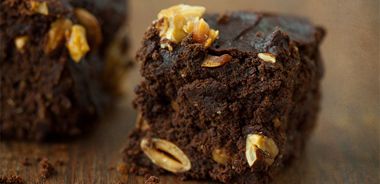Chocolate Crunch Brownies

Sacha inchi seeds can lend interesting texture and taste to all kinds of baked goods. These gooey bite-sized brownies with a crunch are a perfect example. Because they are relatively low in fat and calories, they are one sweet treat you can indulge in with near impunity!
2/3 cup (160 mL) low-fat cream cheese
2/3 cup (160 mL) coconut palm sugar or sucanat
1/2 cup (125 mL) unsweetened cocoa powder
1 free-range egg
1 tsp (5 mL) vanilla extract
1 Tbsp (15 mL) 1% milk
1/3 cup (80 mL) whole wheat or all purpose flour
1/2 tsp (2 mL) baking powder
1/2 cup (125 mL) crushed caramelized sacha inchi seeds (small chunks)
Preheat oven to 350 F (180 C).
Line 6 in (15 cm) square baking pan with parchment paper.
In large bowl combine cream cheese, sugar, cocoa powder, egg, vanilla, and milk. Beat mixture until smooth. Sift flour and baking powder over cream cheese mixture and fold in lightly with crushed sacha inchi seeds.
Spoon mix into prepared pan and bake for 25 minutes, or until a toothpick comes out clean and top is springy to touch.
Remove from oven and cool a bit before serving. Dust squares with additional sucanat before serving if you like a sweeter square.
Makes 12 bite-sized pieces.
Each piece contains: 152 calories; 4 g protein; 5 g total fat (2 g sat. fat, 0 g trans fat); 21 g total carbohydrates (15 g sugars, 2 g fibre); 74 mg sodium
from "Cook on the WIld Side", alive #365, March 2013




